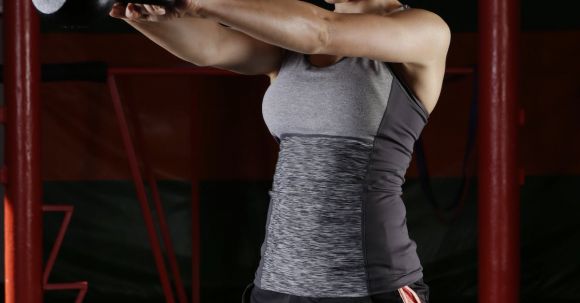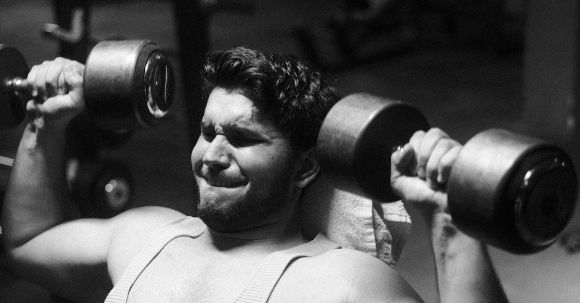Maintaining long-term results with online personal training can be a challenge, but with the right strategies and mindset, it is possible to sustain your progress over time. In this article, we will explore some key tips and techniques to help you stay on track and achieve lasting success.
Blog Posts
Strength training is a popular form of exercise that involves performing various resistance exercises to increase muscle strength and size. One of the key principles that underlies strength training is progressive overload. This principle states that in order to continue making gains in strength, the workload imposed on the muscles must gradually increase over time. In this article, we will explore the science behind progressive overload and why it is essential for achieving optimal results in strength training.
What is Progressive Overload?
Progressive overload refers to the gradual increase in the intensity, duration, or frequency of exercise in order to continually challenge the muscles and elicit further adaptations. Essentially, it means that you need to consistently push yourself beyond your comfort zone to see improvements in strength.Muscle Adaptations to Progressive Overload
When you subject your muscles to progressively increasing demands, they respond by adapting and becoming stronger. These adaptations occur at both the cellular and structural levels. At the cellular level, the number of contractile proteins within the muscle fibers may increase, leading to greater force generation. Additionally, the muscles may become more efficient at utilizing energy and removing waste products, resulting in improved endurance. Structurally, progressive overload can lead to muscle hypertrophy, or an increase in muscle size. This occurs when the muscle fibers undergo microscopic damage during exercise and then repair themselves, becoming thicker and stronger in the process. Over time, this hypertrophy contributes to increased muscle mass and strength.Periodization and Progressive Overload
Periodization is a training strategy that involves systematically varying the intensity, volume, and frequency of workouts over time. It is an effective way to incorporate progressive overload into a training program. By dividing training into specific phases, each with its own goals and demands, periodization allows for the gradual and strategic application of progressive overload. The three main phases of periodization are the macrocycle, mesocycle, and microcycle. The macrocycle refers to the overall training plan, typically spanning several months or even a year. Within the macrocycle, there are mesocycles, which are shorter periods of focused training that target specific goals. Finally, microcycles are the smallest units of training, typically lasting a week, and consist of individual workouts. By manipulating the intensity, volume, and frequency of workouts within each mesocycle and microcycle, progressive overload can be achieved. For example, during the early stages of a training program, the emphasis may be on building a solid foundation of strength. As the program progresses, the workload is gradually increased to continue challenging the muscles and promoting further adaptations.Applying Progressive Overload to Your Training
To effectively apply progressive overload to your strength training routine, you must carefully plan and track your workouts. This involves regularly assessing your current strength levels, setting specific goals, and progressively increasing the demands placed on your muscles. Some ways to implement progressive overload include increasing the weight lifted, performing more repetitions or sets, shortening rest periods, or incorporating more challenging exercises. It is important to note that progression should be gradual and sustainable, allowing for adequate recovery and minimizing the risk of injury. In conclusion, progressive overload is a fundamental principle in strength training that involves gradually increasing the demands placed on the muscles over time. By subjecting the muscles to progressive overload, they adapt and become stronger, leading to improvements in strength and muscle size. Periodization is a useful strategy for incorporating progressive overload into a training program, allowing for systematic variation in intensity, volume, and frequency. By carefully planning and tracking your workouts, you can effectively apply progressive overload and maximize your strength training results.
Losing weight can be a challenging journey, but with the right tools and support, it is possible to achieve your goals. Fit on is a comprehensive fitness app that can help you find your path to weight loss success. With its wide range of features and personalized approach, Fit on is the perfect companion for anyone looking to shed those extra pounds.
Setting Goals and Tracking Progress
The first step towards weight loss success is setting realistic goals. Fit on allows you to set specific goals based on your current weight, desired weight, and timeframe. Whether you want to lose 10 pounds or 50 pounds, Fit on can help you create a plan that is tailored to your individual needs. Once you have set your goals, Fit on makes it easy to track your progress. The app provides a variety of tracking tools, including a food diary, activity log, and weight tracker. By keeping track of your daily food intake and exercise routine, you can stay accountable and make adjustments as needed.Workout Anytime, Anywhere
One of the key features of Fit on is its extensive library of workout videos. From high-intensity interval training to yoga and Pilates, there is something for everyone. The best part? You can do these workouts anytime, anywhere. Whether you prefer to exercise in the comfort of your own home or squeeze in a quick workout at the office, Fit on has you covered.Personalized Recommendations
Fit on takes a personalized approach to weight loss by providing you with tailored workout recommendations based on your goals and fitness level. The app uses advanced algorithms to analyze your data and suggest workouts that are both challenging and achievable. This ensures that you are constantly pushing yourself without risking injury or burnout.Community Support
One of the biggest challenges of weight loss is staying motivated. Fit on understands this and has built a strong community of like-minded individuals who are also on their own weight loss journey. Through the app's social features, you can connect with others, share your progress, and receive support and encouragement when you need it most. This sense of community can make all the difference in your weight loss success.Nutrition Guidance
Exercise is only part of the weight loss equation. Fit on also provides nutrition guidance to help you make healthier choices. The app offers a variety of meal plans and recipes that are designed to support your weight loss goals. Whether you are a vegetarian, have dietary restrictions, or simply want to eat healthier, Fit on can help you make better choices and stay on track.Making Weight Loss Sustainable
Finally, Fit on is not just about quick fixes or crash diets. It is about making weight loss sustainable in the long run. The app focuses on creating healthy habits that you can maintain even after you have reached your goal weight. By incorporating small changes into your daily routine, you can make a big impact on your overall health and well-being. In conclusion, Fit on is a powerful tool that can help you find your path to weight loss success. With its personalized approach, extensive workout library, community support, and nutrition guidance, Fit on has everything you need to achieve your goals. So why wait? Start your journey towards a healthier, happier you with Fit on today.
Kettlebell workouts have gained immense popularity in recent years, and for good reason. This versatile piece of equipment offers numerous benefits that can help you achieve your fitness goals and improve your overall well-being. Whether you're a beginner or an experienced athlete, incorporating kettlebell workouts into your routine can take your fitness to the next level. In this article, we will explore the various benefits of kettlebell workouts and why you should consider adding them to your fitness regimen.
Full-Body Workout
One of the biggest advantages of kettlebell workouts is that they provide a full-body workout in a short amount of time. The dynamic movements and swinging motions engage multiple muscle groups simultaneously, helping you burn calories and build strength. Unlike traditional weightlifting exercises that isolate specific muscles, kettlebell workouts target multiple muscle groups, including your core, legs, arms, and back. This makes kettlebell workouts highly efficient and effective for those with limited time to spend at the gym.Improved Cardiovascular Fitness
In addition to building strength, kettlebell workouts also improve cardiovascular fitness. The explosive movements and continuous swinging motions elevate your heart rate, making it a great form of cardio exercise. Regular kettlebell training can increase your endurance, improve your lung capacity, and enhance your overall cardiovascular health. Whether you're swinging the kettlebell, performing snatches, or doing kettlebell circuits, you can expect to get your heart pumping and improve your cardiovascular fitness.Enhanced Functional Strength
Unlike traditional weightlifting exercises that focus on isolated muscle groups, kettlebell workouts emphasize functional movements. The swinging, flipping, and rotating motions mimic real-life movements, making kettlebell training highly functional. By incorporating kettlebell exercises into your routine, you can improve your strength and stability in everyday activities. Whether you're lifting groceries, carrying your children, or doing household chores, the functional strength gained from kettlebell workouts will translate into improved performance in your daily life.Increased Core Stability
Another significant benefit of kettlebell training is its ability to strengthen your core muscles. The swinging and rotational movements require a strong and stable core to maintain proper form and balance. By consistently incorporating kettlebell exercises into your routine, you will develop a strong core, which is essential for overall strength and stability. A strong core not only improves your performance in other exercises but also helps prevent injuries and promotes better posture.Enhanced Grip Strength
Kettlebell workouts also provide an excellent opportunity to improve your grip strength. The nature of kettlebell exercises, such as swings, snatches, and cleans, requires a firm grip to maintain control of the kettlebell. By regularly performing these exercises, you will strengthen your grip, which can have a positive impact on your performance in various sports and activities that require a strong grip, such as rock climbing, tennis, and weightlifting.Conclusion
Incorporating kettlebell workouts into your routine can offer a wide range of benefits, including a full-body workout, improved cardiovascular fitness, enhanced functional strength, increased core stability, and enhanced grip strength. Whether you're looking to build strength, lose weight, or improve your overall fitness, kettlebell training can be a valuable addition to your fitness regimen. So grab a kettlebell, follow a structured workout plan, and start reaping the benefits of this versatile piece of equipment. Remember to consult with a fitness professional before starting any new exercise program.
Are you looking to push your limits and challenge yourself physically? If so, then the Fit on Strongwoman Competition is the perfect opportunity for you to showcase your strength and determination. This exhilarating event is not just about winning; it's about pushing yourself to new heights and becoming the strongest version of yourself. So, lace up your shoes and let's dive into what it takes to compete in this ultimate test of strength.
Unleash Your Inner Power
The Fit on Strongwoman Competition is a platform that celebrates the power and strength of women. It provides a space for women to showcase their physical abilities and defy societal norms. In this male-dominated arena, women have the opportunity to prove that they are just as capable, if not more, when it comes to feats of strength.Train Like a Beast
To prepare for the Fit on Strongwoman Competition, you need to train like a beast. This means focusing on building your overall strength and conditioning. Incorporate a combination of weightlifting, cardio, and functional exercises into your training routine. Remember, it's not just about lifting heavy weights; it's about having the endurance and stamina to complete the challenges.Develop Full-Body Strength
Strongwoman competitions test your full-body strength, so it's important to train all muscle groups. Work on exercises that target your upper body, lower body, and core. This will ensure that you have a well-rounded strength base to tackle any challenge that comes your way. Remember, a strong core is essential for stability and power, so don't neglect those ab workouts!Master the Events
The Fit on Strongwoman Competition consists of various events that test different aspects of your strength. Some common events include the deadlift, log press, tire flip, and farmer's walk. Take the time to master each event and perfect your technique. Seek guidance from experienced trainers or join a strongwoman training group to learn the tips and tricks of each event.Fuel Your Body
To perform at your best, you need to fuel your body with the right nutrients. Proper nutrition is crucial for recovery and building strength. Focus on consuming a well-balanced diet that includes lean proteins, complex carbohydrates, and healthy fats. Stay hydrated and prioritize getting enough sleep to allow your body to recover and repair.Embrace the Community
One of the most rewarding aspects of participating in the Fit on Strongwoman Competition is the sense of community. Surround yourself with like-minded individuals who share your passion for strength and fitness. Join a strongwoman training group or connect with fellow competitors on social media platforms. Having a support system will not only motivate you but also provide you with invaluable advice and encouragement.Celebrate Your Journey
Competing in the Fit on Strongwoman Competition is an achievement in itself. Regardless of the outcome, celebrate your journey and acknowledge the progress you have made. Every step you take towards becoming stronger is a win. Remember, the power lies within you, and this competition is just the beginning of your incredible journey. In conclusion, the Fit on Strongwoman Competition is an exhilarating opportunity for women to showcase their strength and unleash their inner power. It's a chance to break stereotypes and push your physical limits. By training like a beast, developing full-body strength, mastering the events, fueling your body, embracing the community, and celebrating your journey, you can enter this competition with confidence and determination. So, what are you waiting for? It's time to build your strength and conquer the Fit on Strongwoman Competition!
Emotional eating is a common response to stress, boredom, or negative emotions. It involves using food as a way to cope with these feelings, often resulting in overeating and weight gain. If you find yourself turning to food for comfort, it's important to address the underlying issues and develop healthier coping mechanisms. In this article, we will explore effective strategies to overcome emotional eating.
Understanding the Triggers
The first step in overcoming emotional eating is to identify the triggers. Take a moment to reflect on what emotions or situations tend to lead you to reach for food. Is it stress? Loneliness? Boredom? By understanding your triggers, you can begin to develop alternative ways to deal with these emotions.Find Healthy Alternatives
Once you have identified your triggers, it's time to find healthier alternatives to emotional eating. For example, if stress is a trigger for you, try engaging in stress-reducing activities such as deep breathing exercises, yoga, or meditation. If boredom is the issue, find a new hobby or activity that you enjoy, such as painting, playing an instrument, or going for a walk in nature. By replacing emotional eating with healthier alternatives, you can break the cycle of relying on food for comfort.Practice Mindful Eating
Mindful eating is a powerful tool in overcoming emotional eating. Instead of mindlessly consuming food, take the time to fully experience and appreciate each bite. Pay attention to the taste, texture, and sensation of the food in your mouth. Notice how it makes you feel physically and emotionally. By being present in the moment, you can better understand your hunger and fullness cues, and make more conscious choices about what and how much you eat.Build a Support System
Having a support system in place can make a world of difference when it comes to overcoming emotional eating. Reach out to friends, family, or a therapist who can offer guidance and support during challenging times. Joining a support group or seeking professional help can also provide valuable insights and accountability. Remember, you don't have to face emotional eating alone.Address Emotional Needs
Emotional eating often stems from unmet emotional needs. Take the time to reflect on what you are truly craving – is it comfort, love, or validation? By addressing these underlying emotional needs, you can find healthier ways to fulfill them. Seek out healthy relationships, engage in self-care activities, and practice self-compassion. Remember, you are worthy of love and care.Develop a Balanced Relationship with Food
Lastly, it's important to develop a balanced relationship with food. Instead of labeling foods as "good" or "bad," strive for a more flexible and intuitive approach to eating. Allow yourself to enjoy your favorite foods in moderation, without guilt or shame. Focus on nourishing your body with wholesome, nutrient-dense foods, but also give yourself permission to indulge occasionally. By finding balance, you can break free from the restrictive and emotional cycle of dieting and emotional eating. In conclusion, overcoming emotional eating is a journey that requires self-reflection, self-compassion, and the willingness to seek support. By understanding your triggers, finding healthier alternatives, practicing mindful eating, building a support system, addressing emotional needs, and developing a balanced relationship with food, you can break free from the cycle of emotional eating and cultivate a healthier relationship with yourself and food. Remember, you are capable of overcoming emotional eating and living a more fulfilling, nourished life.
When it comes to fitness, incorporating cardiovascular exercises into your workout routine is essential for maintaining a healthy heart, improving endurance, and burning calories. Whether you're a beginner or a seasoned gym-goer, finding ways to include cardio exercises can sometimes be a challenge. However, with a few simple strategies and a bit of creativity, you can easily incorporate cardio into your workout routine and reap the benefits of a well-rounded fitness regimen.
Start with a Warm-Up
Before diving into any cardio exercises, it's important to start with a warm-up. This will help prepare your body for the workout ahead and reduce the risk of injury. A warm-up can consist of light aerobic exercises such as jogging in place, jumping jacks, or even a brisk walk. Aim to warm up for at least 5-10 minutes before moving on to more intense cardio exercises.Interval Training
One effective way to incorporate cardio into your workout routine is through interval training. This involves alternating between periods of high-intensity exercise and periods of lower intensity or rest. For example, you can try running at a fast pace for 1 minute, followed by 1-2 minutes of walking or jogging at a slower pace. Repeat this cycle for a set number of rounds or a specific duration. Interval training not only helps to increase your cardiovascular endurance but also allows you to burn more calories in a shorter amount of time.Cardio Circuit
Another way to include cardio in your workout routine is by creating a cardio circuit. This involves combining different cardio exercises into a circuit-style workout. For instance, you can choose exercises such as jumping rope, high knees, burpees, or mountain climbers, and perform each exercise for a set amount of time before moving on to the next one. Aim to complete 3-4 rounds of the circuit with minimal rest in between exercises. This not only keeps your heart rate elevated but also helps to target different muscle groups, providing a full-body workout.Incorporate Cardio Machines
If you have access to a gym or fitness facility, incorporating cardio machines into your workout routine is a great option. Machines such as the treadmill, stationary bike, elliptical trainer, or rowing machine can provide a low-impact yet effective cardio workout. Try to vary the intensity and duration of your sessions on these machines to challenge your cardiovascular system and prevent boredom. You can also track your progress by monitoring your heart rate or the number of calories burned during each session.Outdoor Activities
If you prefer to exercise outdoors, there are plenty of activities that can get your heart rate up. Running or jogging in the park, cycling on scenic routes, swimming in a local pool or lake, or even hiking in the mountains are all excellent options for incorporating cardio into your workout routine. The key is to find activities that you enjoy and that fit your fitness level. Remember to always prioritize safety by wearing appropriate gear and staying hydrated.Stay Consistent
Lastly, in order to effectively incorporate cardio into your workout routine, it's important to stay consistent. Aim for at least 150 minutes of moderate-intensity cardio exercise or 75 minutes of vigorous-intensity cardio exercise per week, as recommended by the American Heart Association. This can be divided into smaller sessions throughout the week or combined into longer workouts. By making cardio a regular part of your routine, you'll not only improve your fitness but also reap the long-term health benefits. In conclusion, incorporating cardio into your workout routine is essential for maintaining a healthy heart and improving overall fitness. Whether you choose interval training, cardio circuits, cardio machines, outdoor activities, or a combination of these, finding ways to elevate your heart rate and challenge your cardiovascular system is key. Remember to always start with a warm-up, vary the intensity and duration of your workouts, and stay consistent. With these strategies in place, you'll be well on your way to achieving your fitness goals and enjoying the benefits of a cardio-packed workout routine.
Rest days are often overlooked in the world of strength training. Many people believe that the harder they work and the more they push themselves, the better results they will see. While it is true that hard work and dedication are important, rest days are equally crucial for achieving optimal results in strength training. In this article, we will explore the role of rest days and how they contribute to overall progress and success in strength training.
Muscle Recovery and Repair
One of the primary reasons why rest days are essential in strength training is that they give your muscles time to recover and repair. When you engage in resistance training, you are essentially breaking down muscle tissue. It is during rest days that your body repairs and rebuilds this tissue, making it stronger and more resilient. Without adequate rest, your muscles may not have enough time to recover, which can lead to overtraining, increased risk of injury, and hindered progress.Preventing Overtraining
Overtraining is a common concern among individuals who are passionate about strength training. It occurs when you push yourself too hard without allowing sufficient time for rest and recovery. Overtraining can have negative effects on both your physical and mental well-being. Physical symptoms of overtraining may include decreased strength and endurance, frequent injuries, and chronic fatigue. Mentally, overtraining can lead to decreased motivation, increased irritability, and difficulty concentrating. Incorporating regular rest days into your strength training routine can help prevent overtraining and keep you on track towards achieving your goals.Optimizing Performance and Results
Rest days are not just for physical recovery, but also for mental rejuvenation. When you give your body a break, you give your mind a chance to recharge as well. This mental refreshment can lead to improved focus and concentration during your workouts, ultimately optimizing your performance. Additionally, adequate rest can enhance your body's ability to adapt to the stress of strength training, leading to improved results over time. By allowing your body and mind to recover, you set yourself up for long-term success in your strength training journey.Balancing Training and Life
In the pursuit of strength and fitness goals, it is important to find a balance between training and other aspects of life. Overtraining and neglecting rest days can lead to burnout and decreased enjoyment of the process. Rest days allow you to take a step back, focus on other areas of your life, and maintain a healthy balance. By incorporating rest days into your training routine, you can ensure that you are not sacrificing your overall well-being for the sake of physical gains.Conclusion: The Importance of Rest Days in Strength Training
Rest days play a vital role in strength training. They provide the necessary time for muscle recovery and repair, prevent overtraining, optimize performance and results, and maintain a healthy balance between training and life. By giving your body and mind the rest they need, you set yourself up for long-term success in your strength training journey. So, next time you feel tempted to skip a rest day, remember that rest is just as important as the work you put in at the gym. Embrace rest days as an integral part of your strength training routine and watch as your progress soars to new heights.
In today's fast-paced world, finding time to exercise can be a challenge. However, with the rise of high-intensity interval training (HIIT), it has become easier than ever to stay fit and healthy without leaving the comfort of your own home. HIIT workouts are short, intense bursts of exercise followed by brief rest periods, making them ideal for those with busy schedules. In this article, we will explore the benefits of HIIT workouts and provide you with some valuable tips on how to incorporate them into your daily routine.
The Benefits of HIIT Workouts
HIIT workouts have gained popularity for a reason. Not only are they efficient, but they also offer a wide range of benefits. One of the main advantages of HIIT is that it helps to improve cardiovascular fitness. By pushing your body to its limits during short bursts of intense exercise, you can increase your heart rate, strengthen your heart muscle, and improve your overall endurance. Another benefit of HIIT workouts is their ability to burn calories and promote weight loss. HIIT workouts are known to be highly effective at burning fat, even after the workout is over. This is because HIIT increases your metabolic rate, allowing your body to continue burning calories long after you've finished exercising. Furthermore, HIIT workouts are versatile and can be tailored to suit your fitness level and goals. Whether you're a beginner or an experienced athlete, HIIT exercises can be modified to challenge your body and help you achieve your desired results. From bodyweight exercises like squats and push-ups to more advanced movements like burpees and mountain climbers, the possibilities are endless.How to Incorporate HIIT into Your Routine
Now that you understand the benefits of HIIT workouts, let's dive into how you can incorporate them into your daily routine. Here are some tips to get you started: 1. Set Aside Time: Schedule specific time slots for your HIIT workouts. Treat them as non-negotiable appointments with yourself and make sure to stick to them. 2. Choose a Suitable Space: Find a dedicated area in your home where you can perform your HIIT workouts. Make sure you have enough space to move around freely and safely. 3. Warm-Up: Before diving into the high-intensity exercises, it's essential to warm up your muscles and joints. Spend a few minutes doing dynamic stretches or light cardio to get your body ready for the workout. 4. Structure Your Workout: Design your HIIT workout by selecting a few exercises and determining the work and rest periods. Aim for 20 to 30 seconds of intense exercise followed by 10 to 15 seconds of rest. Repeat this cycle for a total of 10 to 15 minutes. 5. Stay Hydrated: Hydration is crucial during any workout, so be sure to have a water bottle nearby. Take sips of water during your rest periods to stay hydrated throughout the session. 6. Listen to Your Body: While HIIT workouts are challenging, it's important to listen to your body and not push yourself beyond your limits. Start with shorter intervals and gradually increase the intensity and duration as you become more comfortable.Challenge Yourself and Reap the Rewards
By incorporating HIIT workouts into your routine, you can challenge yourself in new and exciting ways. Not only will you see improvements in your fitness levels, but you will also experience the mental and emotional benefits of regular exercise. So, grab your workout mat, put on some energetic music, and get ready to push yourself to new heights with HIIT workouts at home. Your body will thank you for it!
Every athlete dreams of reaching their peak performance level. Whether you are a professional athlete or a recreational sports enthusiast, sports-specific training can help you achieve your goals. This type of training focuses on the specific demands of your chosen sport, helping you develop the skills, strength, and endurance needed to excel. In this article, we will explore the benefits of sports-specific training and provide some tips on how to incorporate it into your fitness routine.









